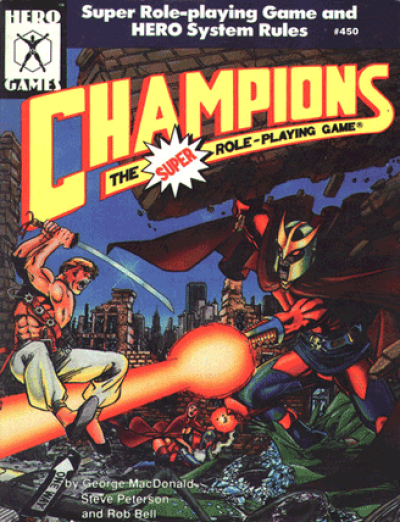The Color Symphony
Champions, 4th Edition
By George MacDonald, Steve Peterson & Rob Bell

30 Mar, 2019
Hero Games’ Champions wasn’t the first superhero roleplaying game1 or even the first SHRPG I played2. It was, however, the SHRPG I played the most often.
Originally published in 1981, the system was initially developed in a rather haphazard way; rules accreted across several editions of rule books. Efforts to correct this lack of organization began in the mid-1980s. 1989’s 4th Edition Champions, written by George MacDonald, Steve Peterson, and Rob Bell was arguably the culmination of this process. Known as the Big Blue Book, it was a fan favorite that shaped many games that came after it.
How does the rulebook stand up after OH GOD HOW IT IS 30 YEARS ALREADY?
Well, for one thing, the binding on this beautiful hardcover was kind of crap. Every copy I have owned had a cracked or broken spine. At least it had an eye-catching George Perez cover, an indication that this was intended as an elite edition.
But as to game mechanics: it’s an early 1980s game (reflected in the fact the text acknowledges it uses only "he" or "him" because in their view inclusive word choice would be too cumbersome.). At that time (in the long gone and distant past) complexity was seen as positive. The designers were also comfortable expecting players to do math. Nothing complicated, but it was best to have a calculator handy.
In the hands of someone familiar with the system, play could be flexible. Flexible enough that one could design characters that broke the game. One could design a side-arm that would punch holes through planets. One could spend points on a headquarters that could own the universe. One could craft attacks that could destroy the universe. It was up to game masters to say “no” when appropriate.
The system was originally designed3 to handle people ranging in power from your squishy Uncle Bens4 to your Supermen. As a consequence, the system was extremely granular at the lower end. As well, because of the way round-offs worked, certain ability values were much more cost effective than others. The result was that characters’ abilities tended to cluster around certain very specific values.
Again due to the range of characters the system had to handle, combat, while delightfully colourful5, could be ... very deliberately paced, with hours of frantic dice rolling to simulate a minute or so of combat. Still, compared to first edition Dragonquest, it was pretty fast6.
Because the system was so.... I am going to go with “detailed”, learning all of the ins and outs of the system could be a bit challenging. Still, it was easier to learn than Chivalry and Sorcery6. It operated at the upper end of playable complexity7. With no more effort than is required for a PhD in quantum mechanics or to master the whole of the Torah in an unfamiliar language, one was handed an incredibly flexible system that managed to simulate the world of superhero comics with a fair amount of success8.
As a result, although the system has been eclipsed to a fair degree in the OH GOD HOW IS IT 30 YEARS since this edition came out, it’s still an incredibly influential system. Many (and I am tempted to say virtually all) subsequent systems were shaped by it, either emulating design decisions in more user-friendly ways or attempting to reject its excesses. While not the first SHRPG, Champions was in many ways the genre-defining game.
Champions, 4th Edition is available here (DriveThru RPG).
1: That was Superhero 2044. I have never seen a copy.
2: Either V&V or Superworld, both of which I only played once.
3: Hero transformed their mechanics into a generic rules system which they used for a variety of genres. How successful this was depends on the player, although I was never particularly happy with their fantasy rules set. Because the essential rules were scaled for nigh-gods, normals tended to be very limited in their abilities.
4: I was going to say Jimmy Olsen, but Jimmy survived many near-death experiences; he was probably a higher point character than he appeared to be when he stood next to Superman. See also the prose character Travis McGee, who, when built under Champions rules, costs more points than Batman.
5: I was particularly fond of the knock-back rules, which dictated how hard people flew after being punched. In real life, the only times I got hit and went an appreciable distance involved a car and a bull. Not at the same time. Those were two different events.
6: Trust me, this is hilarious.
7: I know this because later editions devolved into unplayable complexity.
8: Speedsters like the Flash being the main exception. I don’t know how many points it would take to build Barry Allen, but it would be lots. Lots and lots.
